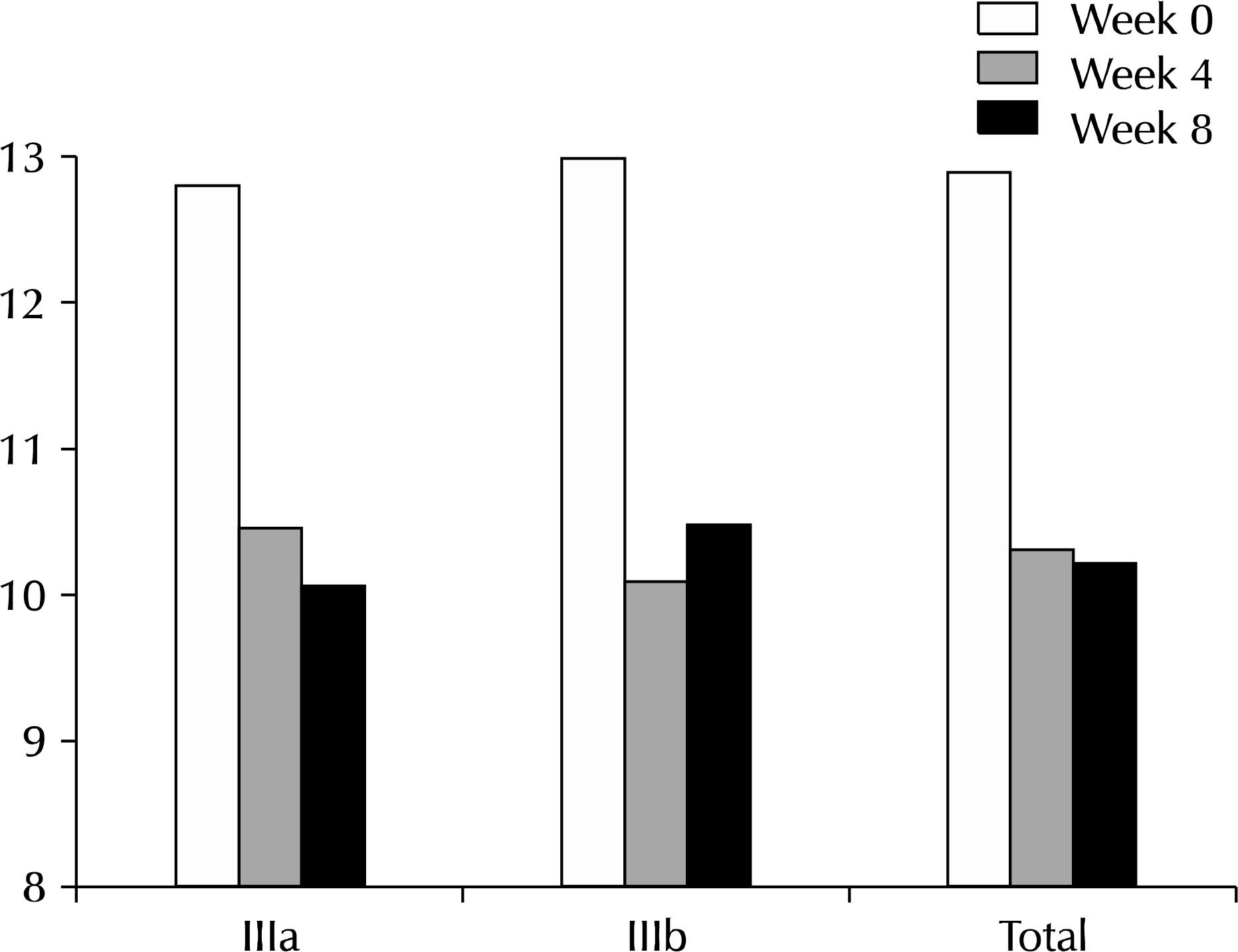Abstract
Purpose
The underlying pathogenic mechanisms of chronic pelvic pain syndrome (CPPS) are unclear. A growing body of evidence suggests that the urogenital pain of CPPS may be neuropathic in origin. The objective of this study was to determine if gabapentin can be an effective treatment for the symptoms of CPPS with severe pain.
Materials and Methods
Thirty five males with CPPS (category IIIa 25, IIIb 10) and the National Institutes of Health Chronic Prostatitis Symptom Index (NIH-CPSI) total pain score ≥9 in the previous six months were enrolled in this study between October 2010 and December 2011. The dosage of gabapentin was increased from 300 mg/d to 600 mg/d during the first four weeks. The primary outcome was evaluated as an improvement in the NIH-CPSI from the baseline to week eight.
Results
This study examined 35 males with CPPS and a mean age of 54.2±9.8 years, mean disease duration of 34.2±27.7 months, and a mean prostate volume of 24.9±5.3 ml. The decrease in the total NIH-CPSI pain domain at four weeks was significant with no change observed after eight weeks. Between the category IIIa and IIIb CPPS patients, the change in the total pain domain was not significant.
Go to : 
References
1. Collins MM, Stafford RS, O'Leary MP, Barry MJ. How common is prostatitis? A national survey of physician visits. J Urol. 1998; 159:1224–8.

2. Rees J, Abrahams M, Doble A, Cooper A. Prostatitis Expert Reference Group (PERG). Diagnosis and treatment of chronic bacterial prostatitis and chronic prostatitis/chronic pelvic pain syndrome: a consensus guideline. BJU Int. 2015; 116:509–25.

3. Nickel JC, Shoskes D, Wang Y, Alexander RB, Fowler JE Jr, Zeitlin S, et al. How does the pre-massage and post-massage 2-glass test compare to the Meares-Stamey 4-glass test in men with chronic prostatitis/chronic pelvic pain syndrome? J Urol. 2006; 176:119–24.

4. Nickel JC, Nigro M, Valiquette L, Anderson P, Patrick A, Mahoney J, et al. Diagnosis and treatment of prostatitis in Canada. Urology. 1998; 52:797–802.

5. Pontari MA, Ruggieri MR. Mechanisms in prostatitis/chronic pelvic pain syndrome. J Urol. 2004; 172:839–45.

6. Woodworth D, Mayer E, Leu K, Ashe-McNalley C, Naliboff BD, Labus JS, et al. Unique microstructural changes in the brain associated with urological chronic pelvic pain syndrome (UCPPS) revealed by diffusion tensor MRI, super-resolution track density imaging, and statistical parameter mapping: a MAPP network neuroimaging study. PLoS One. 2015; 10:e0140250. e0140250.

7. Moore RA, Wiffen PJ, Derry S, Toelle T, Rice AS. Gabapentin for chronic neuropathic pain and fibromyalgia in adults. Cochrane Database Syst Rev. 2014. CD007938.

8. Pontari MA, McNaughton-Collins M, O'leary MP, Calhoun EA, Jang T, Kusek JW, et al. A case-control study of risk factors in men with chronic pelvic pain syndrome. BJU Int. 2005; 96:559–65.

9. Miller LJ, Fischer KA, Goralnick SJ, Litt M, Burleson JA, Albertsen P, et al. Nerve growth factor and chronic prostatitis/chronic pelvic pain syndrome. Urology. 2002; 59:603–8.

10. Desireddi NV, Campbell PL, Stern JA, Sobkoviak R, Chuai S, Shahrara S, et al. Monocyte chemoattractant protein-1 and macrophage inflammatory protein-1alpha as possible biomarkers for the chronic pelvic pain syndrome. J Urol. 2008; 179:1857–61. ; discussion 1861–2.
11. Zhang N, Inan S, Cowan A, Sun R, Wang JM, Rogers TJ, et al. A proinflammatory chemokine, CCL3, sensitizes the heat-and capsaicin-gated ion channel TRPV1. Proc Natl Acad Sci U S A. 2005; 102:4536–41.
12. Yang CC, Lee JC, Kromm BG, Ciol MA, Berger R. Pain sensitization in male chronic pelvic pain syndrome: why are symptoms so difficult to treat? J Urol. 2003; 170:823–6. ; discussion 826–7.

13. Yilmaz U, Liu YW, Berger RE, Yang CC. Autonomic nervous system changes in men with chronic pelvic pain syndrome. J Urol. 2007; 177:2170–4. ; discussion 2174.

14. Sator-Katzenschlager SM, Scharbert G, Kress HG, Frickey N, Ellend A, Gleiss A, et al. Chronic pelvic pain treated with gabapentin and amitriptyline: a randomized controlled pilot study. Wien Klin Wochenschr. 2005; 117:761–8.

15. Lewis SC, Bhattacharya S, Wu O, Vincent K, Jack SA, Critchley HO, et al. Gabapentin for the management of chronic pelvic pain in women (GaPP1): a pilot randomised controlled trial. PLoS One. 2016; 11:e0153037.

16. Dworkin RH, Corbin AE, Young JP Jr, Sharma U, LaMoreaux L, Bockbrader H, et al. Pregabalin for the treatment of postherpetic neuralgia: a randomized, placebocontrolled trial. Neurology. 2003; 60:1274–83.

17. Pontari MA, Krieger JN, Litwin MS, White PC, Anderson RU, McNaughton-Collins M, et al. Chronic Prostatitis Collaborative Research Network-2. Pregabalin for the treatment of men with chronic prostatitis/chronic pelvic pain syndrome: a randomized controlled trial. Arch Intern Med. 2010; 170:1586–93.

18. Taylor CP. The biology and pharmacology of calcium channel alpha2-delta proteins Pfizer Satellite Symposium to the 2003 Society for Neuroscience Meeting. Sheraton New Orleans Hotel, New Orleans, LA November 10, 2003. CNS Drug Rev. 2004; 10:183–8.
19. Devi P, Madhu K, Ganapathy B, Sarma G, John L, Kulkarni C. Evaluation of efficacy and safety of gabapentin, duloxetine, and pregabalin in patients with painful diabetic peripheral neuropathy. Indian J Pharmacol. 2012; 44:51–6.

20. Toth C. Substitution of gabapentin therapy with pregabalin therapy in neuropathic pain due to peripheral neuropathy. Pain Med. 2010; 11:456–65.

Go to : 
Table 1.
Baseline characteristics of the patients
Table 2.
Outcome measurements based on the NIH-CPSI pain domain at baseline, four weeks and four weeks
| Category of CPPS | Sum of pain domain (differences from baseline) | |||||
|---|---|---|---|---|---|---|
| Baseline | At 4 weeks | p-valuea) | At 8 weeks | p-valueb) | p-valuec) | |
| IIIa (n=25) | 12.80±2.43 | 10.47±3.77 (2.33±3.38) | 0.0124 | 10.07±3.65 (2.73±3.22) | 0.0031 | 0.7048 |
| IIIb (n=10) | 13.00±2.20 | 10.10±3.50 (2.90±2.32) | 0.0369 | 10.50±4.30 (2.50±3.40) | 0.1190 | 0.8221 |
| Total (n=35) | 12.88±2.36 | 10.32±3.67 (2.56±2.97) | 0.0009 | 10.24±3.93 (2.64±3.31) | 0.0011 | 0.9301 |




 PDF
PDF ePub
ePub Citation
Citation Print
Print



 XML Download
XML Download